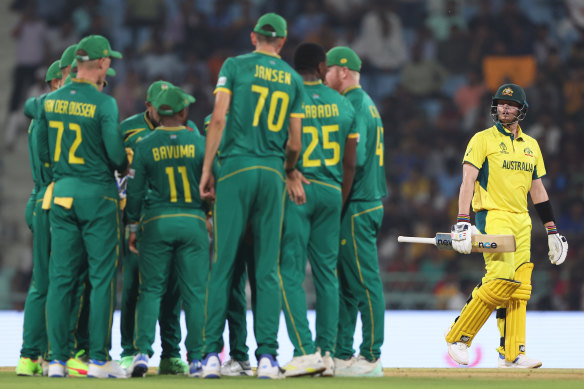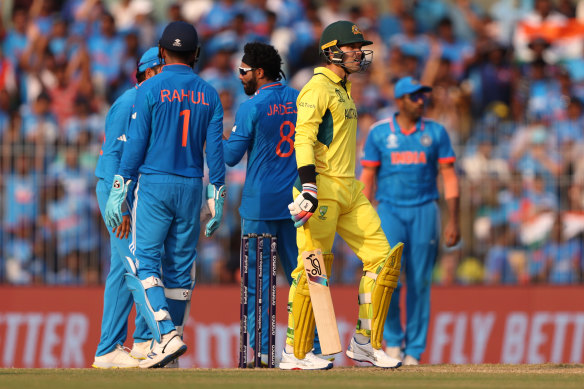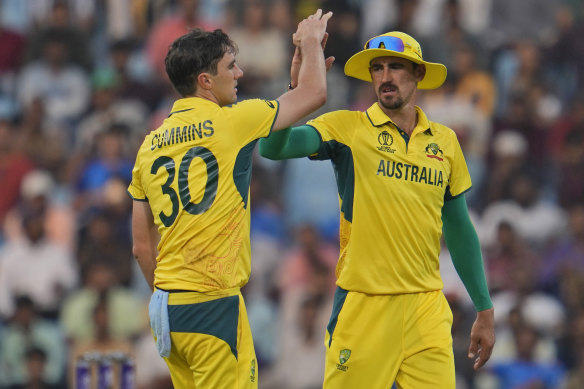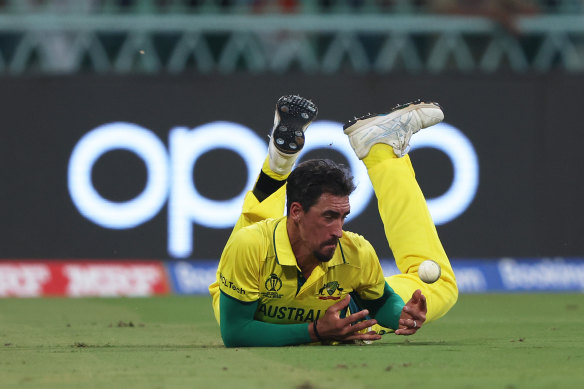Save articles for later
Add articles to your saved list and come back to them any time.
Lucknow: Not so fun fact: Walter Burley Griffin, the American architect who designed Canberra, spent the last two years of his life in Lucknow and died there in 1937. India is where lots of Australia’s best ideas come to die. The latest in mortal danger is Australia’s World Cup campaign. What has gone so wrong? Is it fatal?
Steve Smith makes his way off after being dismissed against South Africa.Credit: Getty Images
Weariness
In the past 12 months, Australia have played 15 Tests – including premium series in India and England – 16 one-day internationals and eight T20 internationals, as well as stints in the IPL for some. It’s been full-on.
A core group has been there for nearly all of it. Cameron Green looks tired and Alex Carey has not had time to process what evidently was a more traumatic aftermath from the Jonny Bairstow day at Lord’s than he could have imagined.
Suddenly, projected long-term players Green and Carey are both out of Test and one-day teams, and coming up right after this break, there’s an Australian summer. It’s not just the present that is being compromised.
Selection
This can be broken down in several ways. One is philosophical. Former coach Bob Simpson used to say that Australia’s best players are the best in any format, but that was a long time ago. The Australian squad looks more like a modified Test outfit than a customised one-day unit. This is in contrast to England’s tailor-made team, for instance.
Partly, this is because 50-over cricket is so little played now that there is virtually no exposed long-term form to act as a guide. Australia have played 16 one-dayers this year, but 10 of them have been in an unholy and as it happens destabilising rush in the past five weeks.
The domestic one-day series is under way in Australia, but if the selectors thought that was useful to their deliberations, Jake Fraser-McGurk would be rushed to India today. He won’t be.
Then there’s injured players. Leg-spinner Adam Zampa, with recent neck and shoulder stiffness, looks sore, though coach Andrew McDonald denied it. Marcus Stoinis spent his first two weeks in India rehabbing a hamstring and looked rusty upon his return on Thursday night. That dropped catch …
Above all, Australia are holding a place for Travis Head and his broken but healing hand. This is understandable, as his uninhibited lead-off stroke play and capable off-spin were central to Australia’s blueprint. The latest bulletin is that he is meeting targets and will be on a plane soon. Even then, Australia are relying on him to recapture his best form immediately. Carrying an injured player is fraught enough. Depending on him is a gamble.
McDonald played a Test-quality dead bat. “I’ve got great trust in the people that we’ve got in the squad,” he said. “We’re focused on what we’ve got there. We’re not performing the way that we would like and we’re going to be critiqued around that and we should be critiqued. We’ve got to turn it around.”
Tactics
Or is it capabilities? Australia’s inability to accelerate with the bat is a well-documented sore point. It is why they were originally reluctant to play both Steve Smith and Marnus Labuschagne, good as they are.
It is also why Carey was dropped as well as Green, stunning former skippers Michael Clarke and Tim Paine. McDonald said Green was not so much dropped as Stoinis restored. But Carey’s axing unwittingly casts him as a scapegoat.
Alex Carey lost his place in the side after Australia’s defeat to India.Credit: Getty Images
“We haven’t been able to navigate through the middle as well as what we’d like,” McDonald said. “We’ve relied on top order starts to get the big totals that are required.”
Against South Africa, acceleration wasn’t the issue. Starting was. They were unlucky in that the pitch died as the day wore on, making strokeplay more difficult in the evening. But there are only so many alibis.
Having picked Josh Inglis, Australia cannot discard him after one game. McDonald acknowledged this.
“Like any of those moves, I think you look over a period of time to critique, not just one game in isolation,” he said. “So it’s probably a trend [with the] middle order and unfortunately Alex missed out.”
And is now in limbo.
Australia’s other headache is spin bowling, delivering it and playing it. Australia think this was overblown after they were hypnotised by three Indian tweakers in Chennai. They suspect the match was played there rather than in Ahmedabad explicitly because it turns so much. They don’t expect spin to play as central a part at other venues.
Adam Zampa is in mediocre form, but Glenn Maxwell’s cultured spell on Thursday night was Australia’s best performance.
In any case, their options are limited. Little seen Tanveer Sangha is in the squad, but Australia will not play two wrist-spinners in the same team and are unlikely to play three spinners anywhere.
Otherwise, the attack is OK. South Africa’s 7-311 was an achievable target on Thursday until suddenly it wasn’t.
Australia skipper Pat Cummins and Mitchell Starc.Credit: AP
Leadership
Pat Cummins is in possibly an unprecedented position in Australian cricket history. As a seamer, he is the most expendable of Australia’s acclaimed trio in this format. Sean Abbott stands by, and would stiffen the batting. But as captain, Cummins intends to play every game.
It’s a dilemma batting captains rarely face. But there is a recent precedent: Cummins did sit out one of three matches against India in the prelude.
If Australia wants to change things up, that is one way they could go, without prejudice to any future selection. It’s not as if Smith doesn’t know how to do the job.
There is another aspect. In one-day cricket especially, a bowling captain has much to juggle. Clarke, for one, thinks Cummins is too defensive in the field, more intent on saving runs than taking wickets. “The easiest way to slow scoring is to take wickets, yet we continue in T20 and one-day cricket to try to prevent runs. How is Pat Cummins not bowling in the first 10 overs?”
Starc drops a chance against South Africa.Credit: Getty Images
Fielding
What fielding?
Morale
“They’re pretty stunned,” McDonald said about his charges after the South Africa defeat. “There’s a lot of silence in the room. They’re quality players and it’s hard to keep a quality group down for long. We have been down for longer than we would like as a team.”
Form
Winning form is good form. Losing, not so much. Australia have lost seven of their past eight one-dayers, all in the past month, all by thumping margins. McDonald acknowledged that Australia were in a trough rather than a dip.
Said Cummins after the South Africa match: “If we want to be challenging for this tournament, we’ve got to try and find a way in all conditions, and that’s for the bowlers to try and take wickets and the batters to try and make runs.”
Well, yes.
Light or train at the end of the tunnel?
In a bilateral series, 0-2 is all but dead. In a league, it’s not. Teams have risen Lazarus-like before, most famously Pakistan in 1992, who won only one of their first five matches before gathering themselves up to march to eventual triumph over England in the final at the MCG. But Australia oughtn’t try that away from home without supervision.
Simply, if Australia slip up again, their fate will be out of their hands. They’re good enough, but one-day cricket is a fickle game. The motto for this tournament is: “It Takes One Day”. It’s meant to be hopeful, but for Australia now rings ominously.
Next
Sri Lanka. They’ve also lost both their matches. But they’ve made 300 in both. Australia haven’t made 200 yet. Now would be a good time.
News, results and expert analysis from the weekend of sport sent every Monday. Sign up for our Sport newsletter.
Most Viewed in Sport
From our partners
Source: Read Full Article




